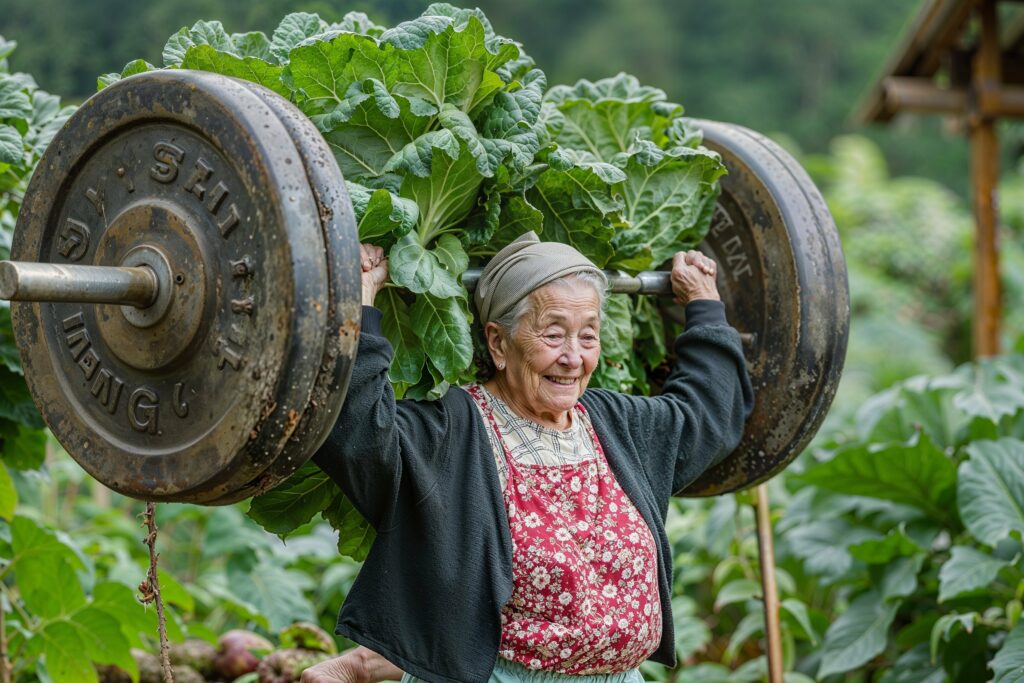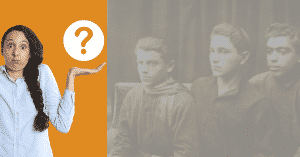I often hear from folks who are hesitant to start exercising because they’re not sure what activities are suitable for their age or they’re concerned about injury. But the truth is, there’s a variety of exercises tailored for the senior population that can help improve flexibility, strength, and balance. Incorporating moderate activities like brisk walking, water aerobics, or yoga can make a world of difference. And for those who may have mobility issues or health conditions, adaptive exercises and equipment are available to ensure everyone can get moving in a way that’s right for them.
Key Takeaways
- Engaging in regular exercise enhances senior health and well-being.
- A variety of exercises are tailored to meet the needs of the elderly.
- Adaptive equipment and exercises ensure everyone can participate.
Understanding Senior Fitness
Imagine your body as a classic car. Just as a vintage ride needs tender love and care to purr along, so does your body, particularly as you move into your golden years.
Age-Related Changes in the Body
You’ve probably noticed some changes as the years tick by. Maybe it takes a bit longer to recover from a long walk, or your joints might sound like a bowl of rice crispies—snap, crackle, pop! These are signs of the natural aging process, where muscle mass tends to diminish, and our bones might lose density. This makes maintaining muscle strength and bone health super important.
The Role of Regular Physical Activity
Listen, staying active is like the best health insurance policy you could give to yourself. Regular exercise can do wonders for your overall health, from managing health conditions to boosting your mental health. It’s a ticket to longevity and improved quality of life. A brisk walk or a groove to your favorite tunes? Believe me, it’s worth it!
Setting Realistic Fitness Goals
Goals, gotta have ’em! But make them realistic. If you haven’t jogged in a decade, running a marathon next month isn’t on the cards. Start with something manageable—maybe walking 10 minutes daily? Gradually, you can up your game. Remember, it’s not about being the fastest or the strongest; it’s about keeping your body moving and enjoying the ride!
Designing an Exercise Plan for Seniors
When it comes to exercise, seniors have unique needs and goals. Remember, it’s never too late to start, and the benefits are waiting just around the corner!
Assessment by Health Professionals
Before lacing up those sneakers, it’s wise to chat with a healthcare provider. They’ll check my current health status and consider any chronic conditions I might have. This is a bit like a personal state-of-the-union. It sets the baseline and ensures I’m picking activities that do me good, not harm. Sometimes they might suggest working with a personal trainer who has experience with seniors.
Creating a Balanced Routine
A well-rounded exercise plan should include a mix of strength, stretching, and balance activities. I balance my week with a bit of everything: Monday and Thursday might be for strength with some light weights; Tuesdays, a bit of yoga for flexibility; and a dance class on Fridays to keep things fun and work on my balance. I aim for moderate-intensity to keep the heart happy without overdoing it.
Incorporating Variety and Enjoyment
The secret ingredient? Enjoyment. If it’s not enjoyable, I won’t stick with it. I mix it up: one day I might go for a brisk walk with a friend, another day I might hit the swimming pool. The goal is to keep it fresh and fun. Oh, and I can’t forget to mention, finding activities that I genuinely like makes me look forward to my workout – it’s a highlight of my day!
Essential Exercise Types for Seniors
When it comes to staying spry into your golden years, a mix of strength, flexibility, balance, and cardio exercises can work wonders. Here’s a breakdown of each exercise type that’s crucial for us seniors.
Strength Training for Muscle Mass
I’m a strong believer that strength training isn’t just for the young and restless. Incorporating strength exercises helps maintain and even build muscle mass, which often declines as we age. You can start with light weights or resistance bands, focusing on major muscle groups. Two of my favorite strength training exercises are seated leg presses and bicep curls. Both easy to do and can be done while enjoying your favorite TV show.
Flexibility Exercises for Mobility
Now, flexibility might not sound as exciting as strength, but hear me out. Simple flexibility exercises like shoulder stretches and calf stretches improve your mobility significantly. Being flexible helps with those little things, like tying shoelaces or reaching for that top shelf. Just a few stretches each morning can keep you nimble.
Balance Exercises to Prevent Falls
Have you ever tripped over a grandkid’s toy? I have, and let me tell you, balance is key to staying upright. Balance training with stand-on-one-leg exercises or heel-to-toe walks can make all the difference. Good balance prevents falls, and as we all know, prevention is better than cure.
Cardiovascular Activities for Heart Health
Lastly, keeping the heart healthy is a big deal. Aerobic activity, like a brisk walk around the park or a gentle cycle, can boost cardiovascular health. Aim for about 150 minutes a week, and if you’re feeling social, grab a friend to chat with as you walk. It’s good for the heart, in more ways than one!
Safety Measures and Injury Prevention
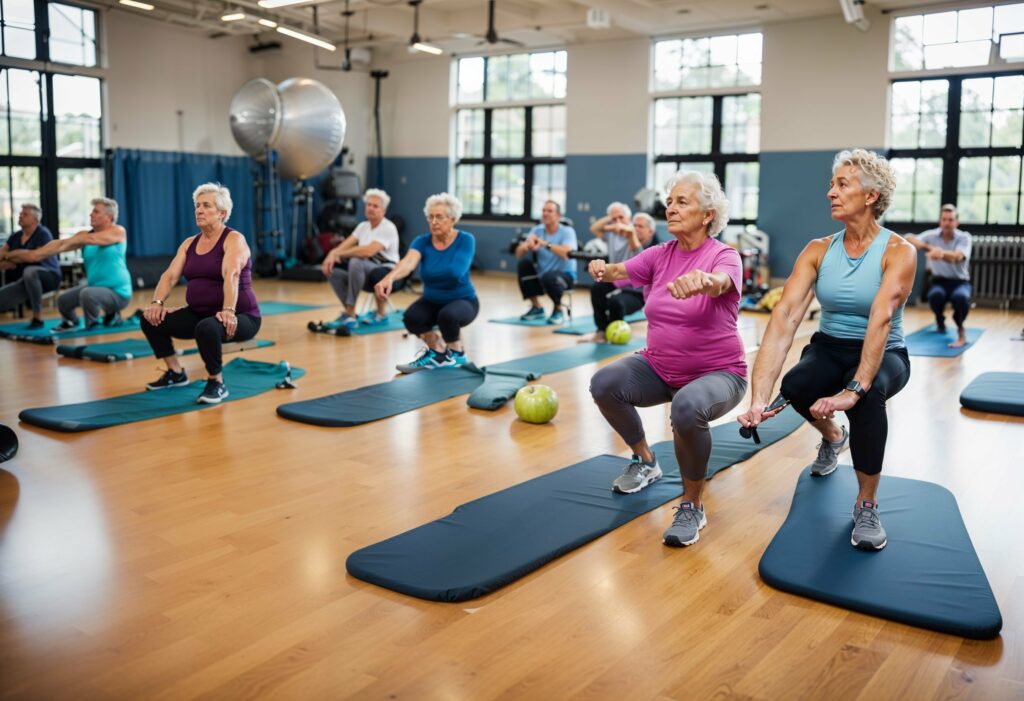
When we talk about staying active in our golden years, it’s crucial to keep in mind that an ounce of prevention is worth a pound of cure. I’ve seen plenty of folks jump into exercises without considering the risks, and let me tell you, a spill at our age is no joke. Let’s dive in, shall we?
Proper Form and Technique
Remember back in the day when we could just wing it and still come out alright? Well, those days are behind us. Proper form is pivotal in preventing injuries, especially when it comes to exercises that target balance and muscle strength. Take it from me, I’ve learned the hard way that maintaining good posture and moving correctly during exercises can make all the difference. I see too many friends sidelined because they got a bit too enthusiastic without knowing the ropes.
- Warm up first: Start with gentle stretches to get those muscles limber.
- Slow and steady: Rushing leads to mistakes. Take your time to perform each movement with care.
Understanding and Managing Health Risks
Knocking on wood here, but managing existing health conditions is key to a safe workout routine. Conditions like osteoporosis, high blood pressure, and heart disease aren’t just words in a medical pamphlet—they’re realities for many of us. Personal story time: I’ve got a friend, let’s call her Sue. She’s got high blood pressure and thought she could handle a high-intensity class. Ended up dizzy and with a scare. Thankfully, Sue’s fine, but it was a wake-up call.
Knowledge is power:
- Consult your doc: Before starting any new exercise, have a chat with your healthcare provider to understand what’s safe for you.
- Listen to your body: If it’s hurting or doesn’t feel right, stop what you’re doing.
By keeping these points in mind, we can ensure that we’re getting the most out of our fitness routines, safely. Stay fit, but more importantly, stay safe out there!
Nutrition and Hydration for Active Seniors
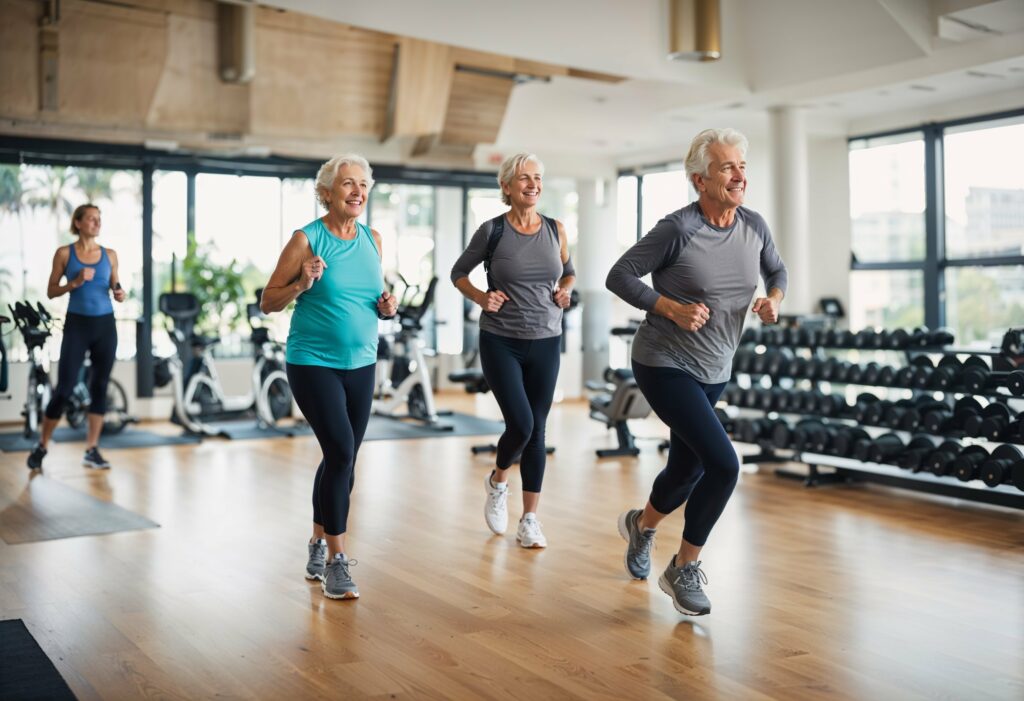
As we age, our bodies don’t forgive those skipped meals or the days we don’t drink enough water like they used to. If you’re like me, out there staying active and giving those youngsters a run for their money, paying attention to nutrition and hydration becomes even more crucial. So what’s on the menu for keeping our overall health and energy up?
It’s all about balance. I make sure my plate is a colorful array of foods – we’re talking fruits, vegetables, lean proteins and, yes, even carbs. They’re not the enemy, my friends. Carbohydrates are our friends for maintaining energy. Choose whole grains for that relentless zest we need to keep moving.
Hydration, hydration, hydration! Water is my elixir for life. Ever notice that when you’re dehydrated, you feel a bit like a wilting plant? That’s because hydration is key, especially for maintaining bone density. No one wants brittle bones!
Here’s a quick reference for fitting these essentials into your diet:
- Fruits and Vegetables (4-5 servings/day)
- Whole Grains (3 servings/day)
- Lean Protein (meats, beans, nuts; 2-3 servings/day)
- Dairy or Calcium-Rich Alternatives (2-3 servings/day)
As for water, I follow the good ol’ “color of your urine” trick. It’s like a personal hydration meter—aim for light yellow.
Remember, these suggestions aren’t just guidelines for the average Joe. They’re the bread and butter for us spirited seniors wanting to keep up our active lifestyle. Listen, I’ve been through the trials and errors, so you can take my word for it. Stay consistent and watch your vitality soar!
Adaptive Exercises and Equipment
Some days, I find that my get-up-and-go just got-up-and-went. On those days, adaptive exercises and equipment are my allies. It’s all about working with what you have to maintain that zest for life.
Exercises for Limited Mobility
When my hips aren’t as cooperative as I’d like, seated hip marches can be a game-changer. Here’s what I do: I sit in a sturdy, non-slip chair and march my legs up and down. It’s a great way to keep those hip joints moving. For added resistance, I sometimes use resistance bands around my thighs. Remember, the key is to move within your comfort zone.
Using Assistive Devices
I always say, “There’s no shame in using a little help.” Assistive devices like a cane or a walker can boost mobility. I incorporate them into my routine by adding arm lifts or small squats, making sure I’ve got a firm grip on my assistive device. It’s about being smart and safe with your movements.
Chair-Based Exercises
Ah, the trusty chair – it’s not just for sitting! I use my chair for chair-based exercises to build strength and balance. With a sturdy chair, I perform seated leg extensions or even some light upper-body stretches and twists. My chair is my steady companion, ensuring I don’t take a tumble.
Managing Exercise with Health Conditions
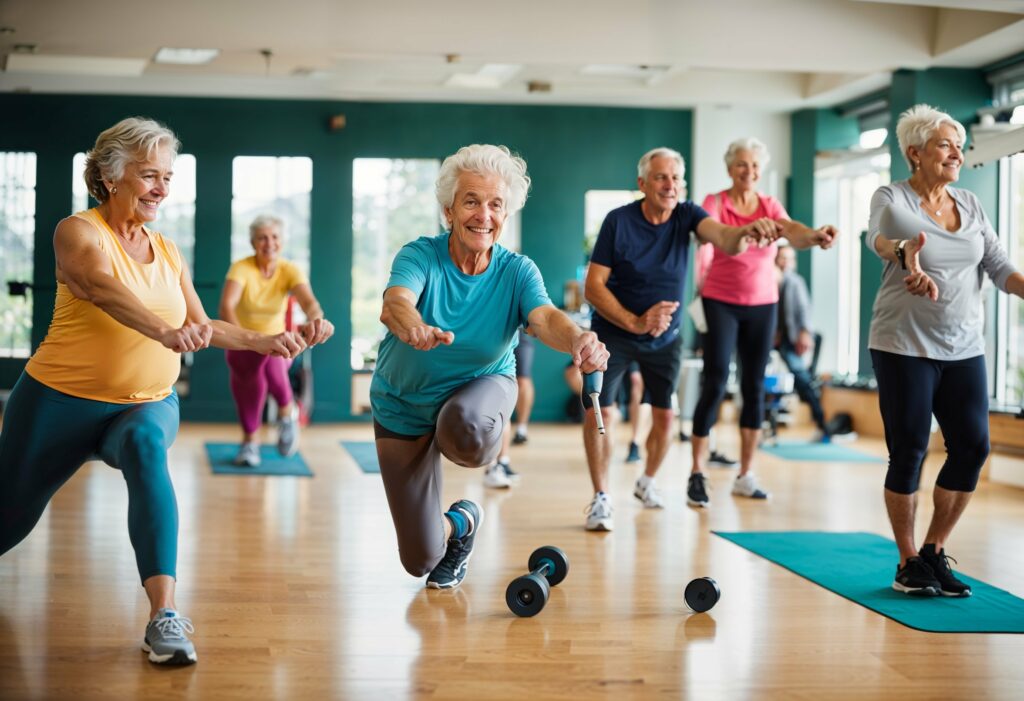
When you’ve got a health condition, exercise becomes a balancing act. But guess what? The right moves can help you manage your condition and boost your well-being.
Exercise and Heart Disease
If you’re like me, you know heart disease doesn’t mean putting your feet up forever. In fact, getting regular exercise is key. It’s like oil for your engine, really. It helps to lower blood pressure and improve cholesterol levels. Just take it slow – maybe start with a brisk walk or a gentle swim. And always have a chat with your doc before starting any new exercise routine.
Physical Activity with Diabetes
For folks with diabetes, lace up those sneakers because physical activity is your friend! Why? It helps control blood sugar, hands down. Incorporate activities like a daily walk or bike ride. It’s not only good for your sugar but also for shedding a few pounds if that’s on your agenda. Just remember, monitor your blood glucose levels, and keep some snacks handy in case they dip.
Exercising with Arthritis
Arthritis may make you want to shun exercise, but don’t let it. Movement is actually a gift to your joints. The key is choosing low-impact activities – think swimming, yoga, or even tai chi. And don’t be shy about using aids like canes or shoe inserts if they help you move more comfortably. Keep it gentle and build up your activity level slowly. Your joints will send you a thank you note, promise.
Psychosocial Benefits of Exercise for Seniors
Engaging in regular exercise can transform your mental and emotional outlook, boost social interactions, and lead to better sleep. Remember, it’s not just about the body; it’s about the mind too.
Mental and Emotional Health
I’ve always found that staying active keeps my spirits high and mind sharp. Exercise can enhance mood and, as studies suggest, has a role in reducing feelings of depression and anxiety. When I take a brisk walk or join a water aerobics session, I can almost feel the stress melting away. It’s a time when I focus on my wellbeing, away from the daily hustle.
Exercise and Social Engagement
One aspect of fitness that doesn’t get enough spotlight is its social side. Joining a class or walking group means connecting with friends who share your goals. It’s not uncommon to hear laughter and chatter as we move. This companionship is vital. It weaves exercise into the fabric of our social life, making it a pleasurable routine rather than a chore.
Improving Sleep and Reducing Anxiety
Lastly, let’s talk about sleep – that golden ticket to feeling refreshed. A good workout can help seniors fall asleep faster and enjoy deeper sleep. And I can vouch for this; on days I’m more active, I slide into sleep like a child. It’s also a fantastic tool for anxiety relief. The calm that follows a workout is unmatched, and it prepares me to handle whatever comes my way with grace.
Building a Supportive Fitness Community
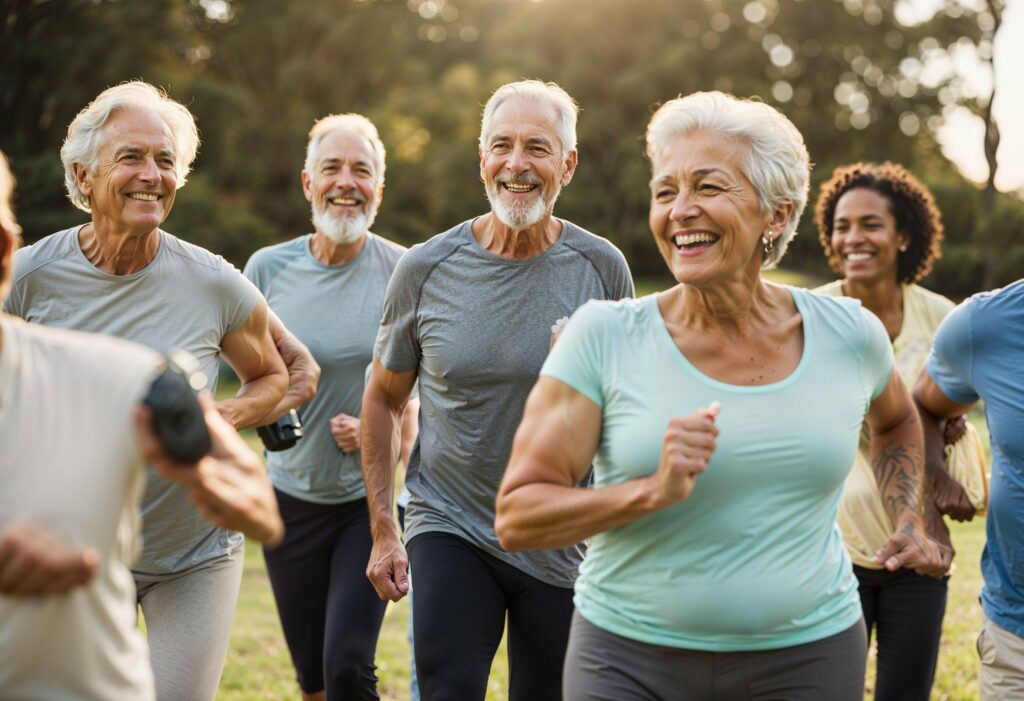
When it comes to staying fit as we age, it’s not just about solo treadmilling at your local gym. What truly makes a difference is the community around you. Trust me, having friends or a personal trainer to cheer you on can turn fitness into a joy rather than a chore.
Centers for Disease Control and Prevention often highlights the importance of combining social support with physical activity. Here’s how to create that tight-knit fitness circle:
Firstly, connect with a fitness buddy. Having a friend join you can make hitting the gym feel like catching up rather than working out.
Consider group classes at your local fitness center. They’re a fantastic place to meet people who share your energy and goals. Plus, it’s motivating to see others working alongside you, isn’t it?
Hire a personal trainer if you can. They’re like tour guides for your fitness journey. They’ll tailor workouts to your needs and keep you on the right path. And they’re fantastic listeners – a little chit-chat can be a big motivator!
Lastly, get involved in community events. Whether it’s a charity walk or a dance-a-thon, it’s fitness for a cause, which doubles the feel-good factor.
Listen, building a fitness community is about creating a support system that makes you look forward to getting active. So reach out, get social, and let’s get moving!
Now, flex that community muscle and watch your fitness journey transform!
Frequently Asked Questions
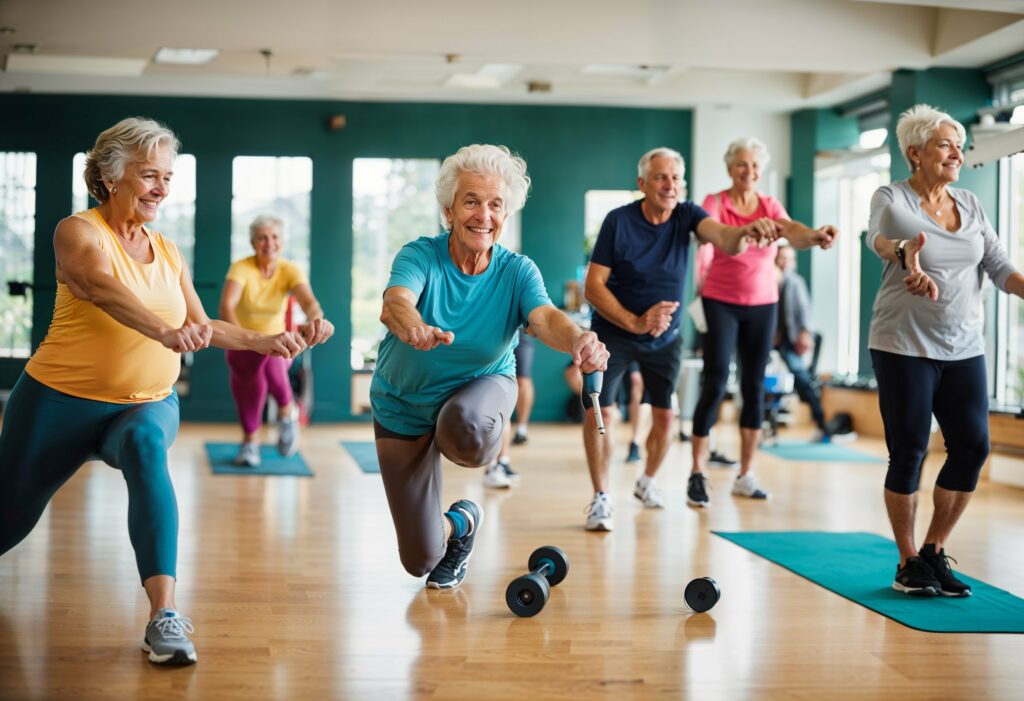
Navigating the world of senior fitness can be filled with questions, but don’t you worry—I’ve got some answers that’ll clear things up. Whether you’re 65 or 85, these bits of wisdom come from years of learning and staying active.
What types of strength training are appropriate for seniors?
For seniors, it’s important to focus on exercises that increase muscle strength without overdoing it. Resistance bands, light weights, and even bodyweight exercises like chair squats can be really effective. I’ve personally found that starting with light hand weights and gradually increasing resistance helps my own muscles stay toned!
Are there particular exercises recommended for seniors above the age of 80?
Absolutely! Seniors above 80 benefit greatly from balance exercises like heel-to-toe walking or standing on one foot with support. Gentle stretching and range-of-motion movements are also key. Remember, it’s about keeping the body moving and improving stability.
How can seniors safely establish an at-home workout routine?
First, clear a space that’s free of clutter to reduce the risk of trips and falls. Then, choose exercises that are easy on the joints like chair yoga or seated leg lifts. I always tell my friends to listen to their bodies—if something hurts, it’s time to stop.
What are the best low-impact exercises for elderly people to maintain fitness?
Swimming, walking, and tai chi rank high on the list of low-impact activities. They help maintain fitness while being gentle on the joints. Just yesterday, I enjoyed a brisk walk in the park; it’s a simple pleasure that keeps me feeling great.
How often should seniors engage in physical activity to promote healthy aging?
According to the National Institute on Aging, seniors should aim for at least 150 minutes of moderate aerobic activity each week. Breaking this down to about 30 minutes a day, five days a week is a manageable goal. And it’s okay to start small; every little bit counts!
What resources offer free or affordable exercise programs tailored for the senior population?
Many community centers and senior organizations offer exercise classes designed for older adults. The National Institute on Aging’s website is a great starting point for finding routines. Just yesterday, a friend mentioned enjoying a free yoga session at our local library!

